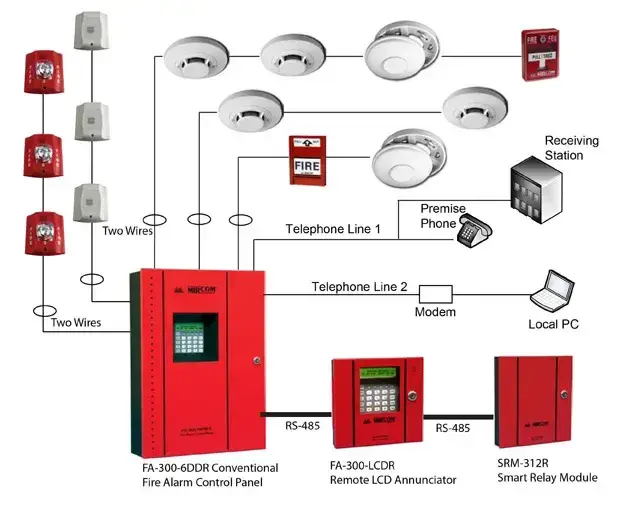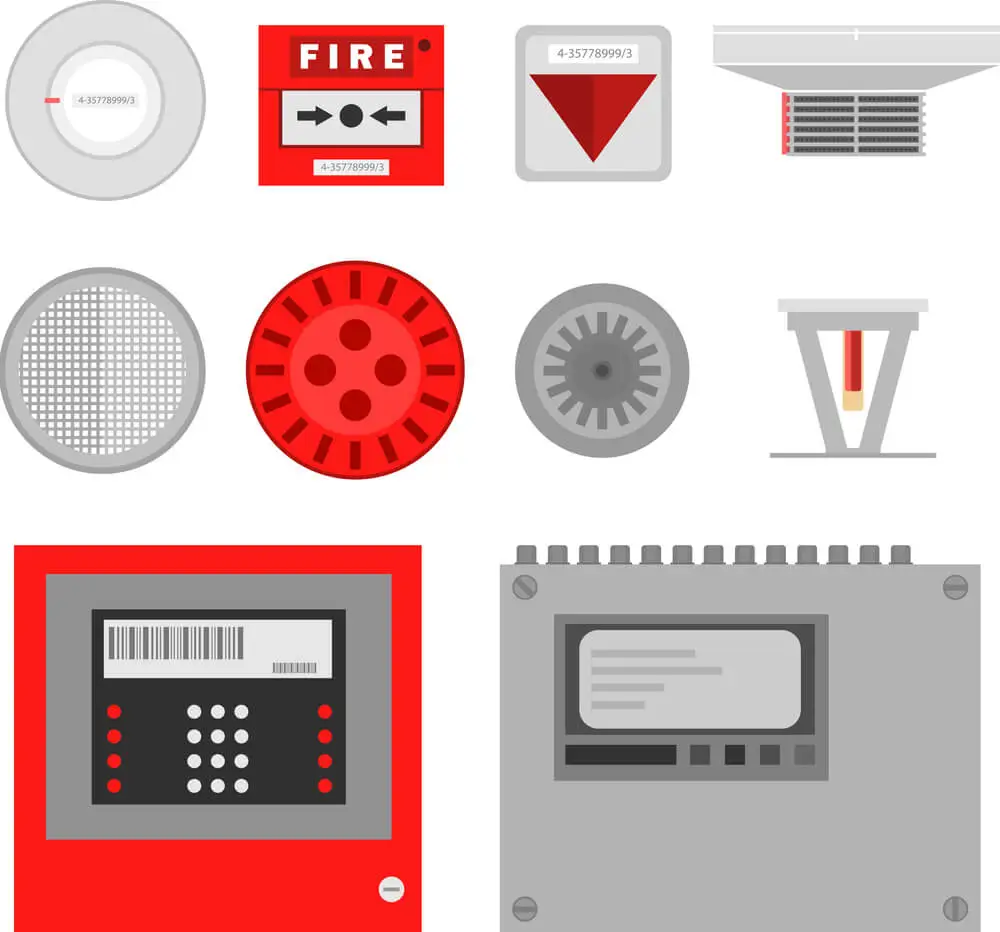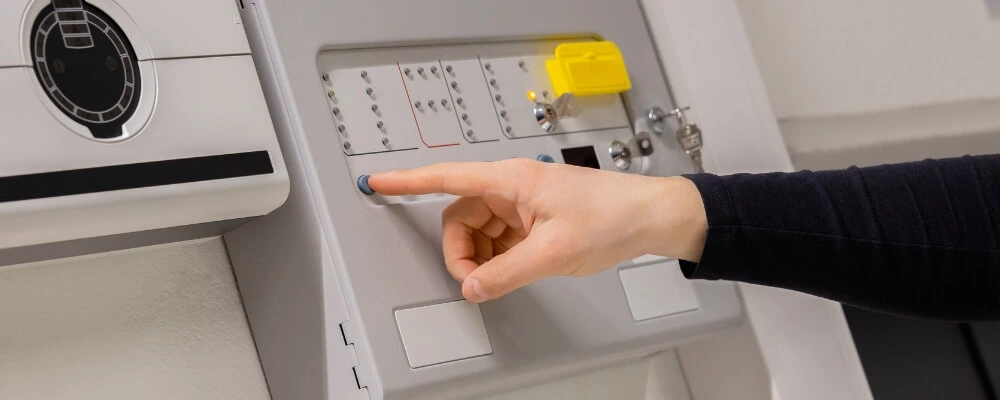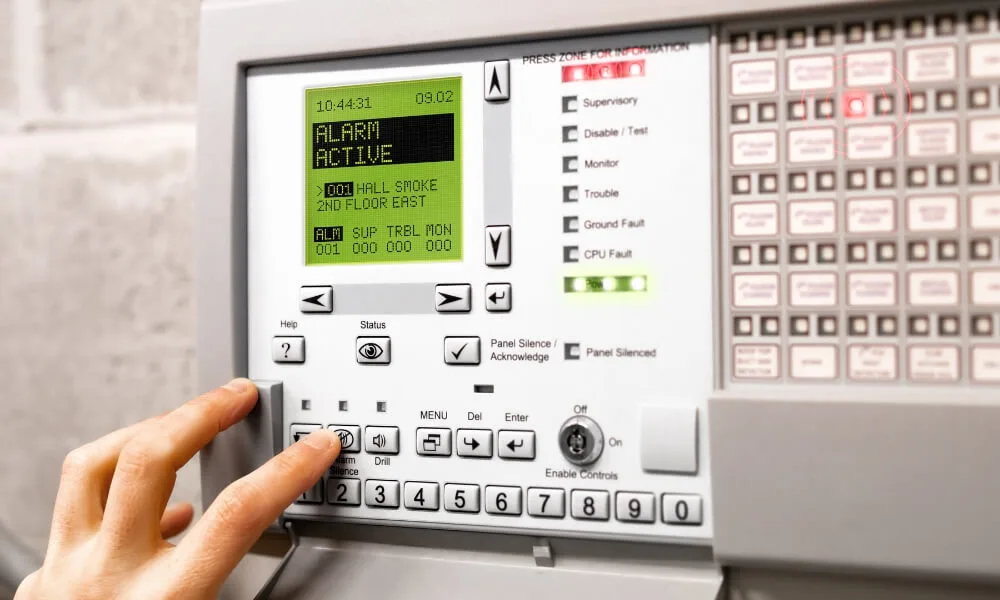In fire safety, where every second counts, Fire Alarm Control Panels (FACPs) stand as vigilant guardians. These unassuming devices hold the power to coordinate an intricate dance of sensors, alarms, and responses, ensuring the safety of occupants and property. From conventional systems to cutting-edge addressable designs, FACPs play a pivotal role in detecting and mitigating fire threats.
In this insightful blog, we plunge into the world of Fire Alarm Control Panels. We’ll delve into the various types that cater to different needs and unveil the inner workings that make these panels the cornerstone of modern fire safety systems. Whether you’re a fire safety enthusiast, a building manager aiming to bolster security, or simply curious about the mechanisms that protect us, join us on this journey as we unravel the complexities and uncover the mechanisms that drive the heart of fire safety technology.
What is Fire Alarm System?
A fire alarm system is a critical network of interconnected devices designed to detect and alert occupants of a building in the event of a fire, smoke, or other emergencies. Comprising various components such as smoke detectors, heat sensors, alarms, and control panels, the system works collaboratively to swiftly identify potential hazards.
When triggered by signals from these devices, the fire alarm system sounds alarms, initiates alerts, and communicates crucial information to occupants, allowing them to evacuate safely and aiding emergency responders in timely intervention. This indispensable system is pivotal in safeguarding lives and mitigating property damage in the face of fire-related threats.
What is Fire Alarm Control Panel?
The fire alarm control panel, also referred to as the fire alarm control unit, is the central command hub of a fire alarm system. It serves as the system’s brain, overseeing the entire network of detectors and sensors distributed throughout the building. Responsible for processing incoming signals, the control panel monitors the environment for signs of fire or smoke.
In case of an emergency situation, the panel takes decisive actions, such as activating alarms, triggering notification devices, and coordinating responses. Equipped with power supply provisions and specialized circuitry for initiating and notifying devices, the fire alarm control panel ensures seamless communication, quick decision-making, and effective management of fire-related events.

Major Components Of A Fire Alarm Control Panel
A Fire Alarm Control Panel (FACP), also known as a Fire Alarm Control Unit (FACU), is a central component of a fire alarm system. It monitors and controls various fire detection and notification devices within a building. The major components of a Fire Alarm Control Panel typically include:
- Control Circuitry: This is the brain of the FACP. It processes signals from different detectors and devices, makes decisions based on programmed logic, and activates alarms or alerts as needed.
- Power Supply: The FACP requires a reliable power source to function. It typically has a primary power source from the building’s electrical system and often includes a backup power source, such as batteries, to ensure operation during power outages.
- Input/Output Modules: These modules allow the FACP to communicate with various fire detection devices, such as smoke detectors, heat detectors, manual pull stations, and sprinkler flow switches. Input modules receive signals from these devices, while output modules trigger alarms, alerts, or control devices like notification appliances and sprinkler systems.
- Display and Interface: The FACP features a display panel that provides information about the system’s status, including the locations of activated detectors, trouble conditions, and system health. This interface helps building occupants and maintenance personnel quickly assess the situation.
- Annunciator Panel: In larger buildings or complexes, remote annunciator panels might be located in different areas. These panels display the status of the fire alarm system, allowing for easier monitoring and response.
- Keypad or Touchscreen: Many modern FACP models have a user-friendly interface, such as a keypad or touchscreen, that enables authorized personnel to interact with the system. This interface allows for tasks like acknowledging alarms, silencing alerts, and performing system tests.
- Communication Interface: The FACP often includes communication capabilities to send alerts to monitoring stations, building management systems, and emergency responders. This can include connections through telephone lines, internet protocols, or cellular networks.
- Zones and Circuits: The FACP divides the protected area into zones or circuits, each containing a specific group of fire detection devices. This zoning helps identify the location of a fire or fault within the building.
- Sounders and Notification Appliances: The FACP can activate various notification appliances, such as strobe lights, horns, sirens, and speakers, to alert building occupants of a fire emergency.
- Reset and Silence Controls: Authorized personnel can use these controls to reset the system after an alarm event and to silence alarms during non-emergency situations.
- Event Logs: The FACP maintains a log of system events, such as alarms, faults, and system tests. This log is crucial for post-incident analysis and system maintenance.
- Enclosure: The FACP components are typically housed within a sturdy enclosure to protect them from environmental factors and unauthorized access.
These components work together to ensure that the fire alarm system effectively detects and responds to fire emergencies, protecting occupants and property within a building. Remember that specific features and components may vary depending on the manufacturer and the specific Fire Alarm Control Panel model.

Major Functionalities Of A Fire Alarm Control Panel
A Fire Alarm Control Panel (FACP) is the central hub for managing a fire alarm system within a building. Its major functionalities include:
- Monitoring Fire Detection Devices: The FACP continuously monitors signals from various fire detection devices, such as smoke detectors, heat detectors, flame detectors, and manual pull stations. It processes these signals to determine if there’s a fire emergency.
- Alarm Activation: When a fire detection device detects a potential fire, the FACP assesses the situation and, if necessary, activates alarms and alerts. This can include activating notification appliances like strobe lights, horns, sirens, and speakers to alert building occupants.
- Zoning and Identification: The FACP divides the protected area into zones or circuits, each corresponding to a specific building section. This zoning helps identify the location of the fire or fault, aiding responders in locating the source quickly.
- Display and Visualization: The FACP displays information about the system’s status on its interface. This information might include the zones where alarms have been triggered, trouble conditions, and system health. The display allows for quick assessment of the situation by building occupants and responders.
- Event Logging: The FACP records system events, including alarms, faults, and system tests. This event log is crucial for post-incident analysis, compliance reporting, and troubleshooting.
- Fault Detection and Reporting: Apart from fire detection, the FACP monitors the health of the fire alarm system itself. It identifies faults, malfunctions, or wiring issues in the system and reports these conditions to building maintenance personnel for prompt resolution.
- Trouble and Supervisory Alerts: The FACP can generate supervisory alerts for conditions such as low battery power, loss of communication with devices, or other non-fire-related issues that require attention. These alerts help ensure the proper functioning of the system.
- Control of Notification Appliances: The FACP can activate or deactivate notification appliances, allowing authorized personnel to control audible and visual alerts during testing, maintenance, and troubleshooting.
- Silencing and Resetting: Authorized personnel can use the FACP to silence alarms during non-emergency situations or to reset the system after an alarm event has been addressed.
- Communication with Monitoring Stations: In some systems, the FACP can communicate with remote monitoring stations, building management systems, and emergency responders. It can transmit real-time information about alarms and system status to ensure a coordinated response.
- Remote Annunciators: In larger buildings or complexes, remote annunciator panels can display the status of the fire alarm system in different areas, providing localized information to building occupants and responders.
- System Testing and Maintenance: The FACP includes features for conducting system tests and maintenance routines. It can simulate alarm conditions, check the functionality of devices, and ensure that the entire system is operational.
Overall, the Fire Alarm Control Panel plays a critical role in fire safety by promptly detecting potential fire emergencies, alerting occupants and responders, and assisting in managing the response to such situations. Its functionalities ensure efficient operation, early detection, and effective communication during fire events.

Different Types Of Fire Alarm Control Panels
1. Conventional Fire Alarm Control Panel
Conventional fire alarm panels are commonly used in smaller buildings or structures. Each zone in the building is represented by an LED on the panel. These panels are cost-effective and simple to install. Each zone typically has smoke detectors and other devices, which transmit signals to the panel in case of smoke or heat detection. The panel has a basic control unit, and the initiating and notification devices are connected to dedicated circuitry for each zone.
2. Coded Fire Alarm Control Panel
Like conventional panels, coded panels incorporate a motor or electronic pulse generator. The panel has a code wheel connected to different zones. As the code wheel rotates due to the motor, changes in the pulse generator create unique codes for each zone. These codes help identify the location of the detected event. However, this type of panel is less common nowadays.
3. Programmable Fire Alarm Control Panel
Programmable panels are customized to meet specific requirements. The circuitry in these panels is programmed to respond to various events, such as fire or smoke. Input and output circuitry are configured based on the desired functionalities. These panels offer flexibility in adapting to different scenarios.
4. Addressable Fire Alarm Control Panel
Addressable panels are commonly used in larger buildings like shopping malls. They require less wiring compared to conventional panels. Each device connected to the panel, such as alarms and detectors, has a unique address or identifier. All these devices are connected to a signaling line circuit. The panel can provide power to and communicate with these devices individually. In case of an emergency, the devices signal the panel with specific information about the location and type of event.
5. Intelligent Fire Alarm Control Panel
Intelligent panels are a subtype of addressable panels. They receive data directly from the sensors placed throughout the building or structure. For example, a smoke detector continuously transmits information about smoke levels. The panel can access detailed data from each detector, helping responders better understand the situation.
These different Fire Alarm Control Panels cater to various building sizes, complexities, and customization needs. They play a vital role in detecting and responding to fire emergencies, ensuring the safety of occupants, and minimizing potential damage. The choice of the panel depends on factors such as building size, budget, required features, and the level of detail needed in event reporting.

Applications Of Fire Alarm Control Panels
Fire alarm control panels are critical components in fire detection and response systems. Their applications are diverse and essential for ensuring the safety of occupants, minimizing property damage, and effectively responding to fire emergencies. Here are some key applications:
- Emergency Notification: Fire alarm control panels are the central hub for receiving signals from fire detection devices such as smoke detectors and heat sensors. When these devices detect the presence of smoke, heat, or flames, the control panel triggers alarms and alerts, notifying building occupants of the potential fire emergency.
- Preventing Structural Damage and Fatalities: By promptly detecting fires, fire alarm control panels contribute to preventing extensive structural damage to buildings and, more importantly, safeguarding human lives. Early detection allows for faster response, preventing fires from spreading and causing substantial harm.
- Alarming and Evacuation: Fire alarm control panels facilitate the orderly evacuation of buildings during fire emergencies. The audible and visual alarms triggered by these panels alert occupants to the danger, enabling them to follow established evacuation procedures and exit the premises safely.
- Integration with Sprinkler Systems: Many fire alarm control panels are integrated with automatic fire sprinkler systems. In the event of a fire, the control panel can activate the sprinklers to suppress or extinguish the flames, helping to control the fire’s spread and limit its damage.
- Fire and Smoke Control: Fire alarm control panels can interface with fire suppression systems, such as smoke control systems and doors. These interfaces can aid in containing the fire’s progression and limiting its impact on different building areas.
- Hazard Alerting: Beyond fire emergencies, fire alarm control panels can also detect other hazards, such as gas leaks or chemical spills. The panels can provide early warnings for various hazardous situations when equipped with the appropriate sensors.
- Property and Life Protection: Fire alarm control panels protect property and lives. Rapidly detecting fires and initiating the necessary response measures help minimize property damage and prevent injury or loss of life.
In summary, fire alarm control panels are instrumental in maintaining a safe building environment. Their applications extend from detecting and alerting to coordinating responses, evacuations, and even engaging fire suppression systems. By fulfilling these roles, fire alarm control panels contribute significantly to reducing the potential impact of fire emergencies and ensuring the well-being of occupants and property.

Advantages Of A Fire Alarm Control Panel
Fire alarm control panels offer numerous benefits in enhancing fire safety and response capabilities. Here are the key advantages:
- Integration with Other Systems: Fire alarm control panels can integrate with various building systems such as HVAC (Heating, Ventilation, and Air Conditioning) and access control. This integration allows for coordinated responses, such as activating air handling systems to prevent smoke spread and controlling access to certain areas during emergencies.
- Effective Warning: Fire alarm control panels provide accurate and timely warnings about potential fire incidents to occupants. The panel’s ability to interpret signals from multiple fire detection devices ensures that alarms are triggered promptly, allowing occupants to take appropriate actions swiftly.
- Communication with Multiple Fire Sensors: These panels can communicate with various fire sensors, including smoke detectors, heat sensors, and flame detectors. This comprehensive coverage ensures that various fire hazards are detected and responded to effectively.
- Rapid Notification: Fire alarm control panels can quickly relay emergency alerts to building occupants, enabling them to evacuate promptly and follow established safety procedures. This speed is critical for minimizing the potential impact of a fire event.
- Prevention of Structural Damage and Asset Protection: By detecting fires in their early stages, fire alarm control panels play a vital role in preventing extensive structural damage to buildings. Additionally, they help safeguard assets within the building, such as equipment, documents, and valuable resources.
- Life-Saving Potential: These panels’ swift detection and notification capabilities significantly save lives. Early warnings empower occupants to evacuate safely, reducing the risk of injuries or fatalities during fire emergencies.
- Cost-Effective Monitoring: Fire alarm control panels can centralize monitoring and management of fire detection devices. This centralized approach reduces the need for constant physical checks and minimizes monitoring costs, making fire safety more efficient and economical.
- Automated Activation of Fire Suppression: In buildings equipped with fire suppression systems like sprinklers, fire alarm control panels can automatically trigger these systems upon detecting a fire. This automated response helps contain and suppress the fire, limiting its spread and impact.
In summary, fire alarm control panels offer comprehensive advantages that enhance fire safety and protection. From timely warnings and effective communication to preventing damage and even potential cost savings, these panels are integral to creating a safer environment for building occupants and assets.
Conclusion
The Fire Alarm Control Panel (FACP) is an indispensable force in fire safety. Its ability to seamlessly orchestrate a symphony of detection, response, and communication proves to be the backbone of any effective fire alarm system. Throughout this exploration of FACP types and functionality, we’ve witnessed the evolution from conventional to addressable systems, each catering to unique needs while collectively striving for the utmost security.
From its unassuming exterior, the FACP’s inner workings come alive, ensuring that the crucial information gathered by various sensors translates into timely alerts, swift responses, and, ultimately, lives and property saved. Whether in a sprawling complex or a modest structure, the FACP’s role remains consistent: to detect danger, communicate efficiently, and empower building occupants and responders to take action.
As technology advances, the Fire Alarm Control Panel adapts, integrating seamlessly with other systems and providing an essential line of defense against fire emergencies. With a deeper understanding of its types and operations, we can appreciate the intricate dance of innovation and necessity that fuels the world of fire safety. As we look ahead, the Fire Alarm Control Panel will continue to evolve, serving as a beacon of security in an ever-changing landscape.

